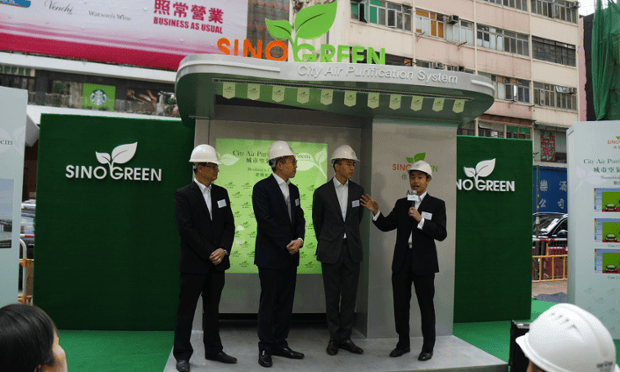Adapting to air pollution with clean air stands in China
Posted on 24 August 2015 by John Abraham
To adapt or to mitigate? That is the question that faces governments and industries across the globe as the impacts of climate change and pollution become ever clearer. It turns out, we will need to do both. The longer we allow pollution to be freely emitted, the fewer and more expensive will be the choices remaining to us.
Pollution adaptation can take many forms, but it generally means dealing with a pollutant after it has been emitted, or it can mean changing infrastructure to make it more resilient to heavy rains, floods, or more intense storms.
One great example of adaptation is being developed in Hong Kong and elsewhere in Asia by a major engineering company (Arup Engineering) and the CSR arm of a Hong Kong property developer (Sino Green). Arup and Sino Green are dealing with the environmental problem of localized airborne pollution.
In many parts of the world, airborne pollution levels are very high and can be elevated for long periods of time. These high levels of pollution can pose health problems to people and animals, particularly people with other health problems or those who are young or the elderly. In some cases, the airborne pollution levels can be at high levels for 8,000 hours (90%+) in a single year.
There are many sources of pollution; for Arup Engineering, whose East Asia headquarters is in Hong Kong, much of the pollution is from nearby heavy industries across the border in mainland China and from vehicle emissions. At other locations, high levels of airborne pollution may be caused by burning of wood or dung for fire, slash-and-burn agricultural practices (particularly for countries near Indonesia), or from other causes. But, regardless of the cause, companies such as Arup are trying to find ways to reduce human exposure even when the airborne pollution levels are high.
Arup is embarking on an effort to provide filtered air zones for people who are street side, perhaps waiting for public transportation. Much like a bus stop, the proposed structure (called City Air Purification System) provides clean air flow to create a cocoon around bystanders, shown in the following photograph.

Dr. Jimmy Tong (right) and colleagues from Sino Group. From right to left, Mr. David Ng, Executive Assistant to Chairman, Mr. Daryl Ng, Executive Director, and Mr. Vincent Lo, General Manager, showcasing a patent-pending clean-air stand in Hong Kong.
The stand is able to accommodate approximately 20 people and washes them with filtered air, protecting them from particulates from passing traffic. The company has shown by both experiment and by numerical simulation (similar to a climate model), that the occupants breathe significantly healthier air.
Not only is the Arup/Sino Green structure very energy efficient, but by providing clean air to residents, it is possible to counteract the deleterious health effects on the human body, particularly the respiratory and cardiovascular system.

An installed Arup/Sino Green clean-air stand in Hong Kong.
I asked the lead inventor, Dr. Jimmy Tong (with whom I worked in the past) about this project. He told me,































 Arguments
Arguments






























Based on the reports of the pollution composition and level in China prior to the Olympics, I doubt that these shelters reduce pollutant levels to the US standard for Particulate, SO2, NOx, Ozone and Lead. At 70% reduction it would be marginal. However, the technology to reduce all of these pollutants would require three different technologies. Particulate (and Lead) would likely be the easiest by using a fabric filter. By adding an alkaline material to coat the inside of the fabric filter, the SO2 might be reduced. At great expense a paladium catalyst may address the NOx and Ozone. However, I would have to see a substantial amount of data to beleve any high reduction in the pollutant concentrations. That still does not address the hazardous organic vapors (benzene, toluene, etc.) which would require the addition of activated charcoal for removal.
I am searching for words far beyond "despair".
Is this what homo sapiens calls a "solution"?
The situation must be way out of any control.
Instead of choosing between adaptation and mitigation, I prefer to think of the required action as an adaptation that will mitigate the impacts of human economic development.
The required adaptation is the open admission that much of the currently developed perceptions of prosperity, wealth and power are illusions that are not justified and need to be shattered.
There is a belief that the current measures of wealth and prosperity must be maintained and that the perceptions of the most prosperous must be maintained and continue to increase.
The required adaptation is a change of the way that wealth and prosperity are evaluated. And that change is required even if it means that many of the people currently considered to be very prosperous and wealthy are realised to not deserve the level of wealth or prosperity they have gotten away with developing.
That adaptation will clearly lead to the required mitigation. And it is also clear that without that adaptation, progress of humanity toward developing a lasting better future and lasting growth of the economy will continue to repeatedly fail as the undeserved perceptions of prosperity and wealth continue to be allowed to develop to the point of being impossible to gather popular support for.
It is also clear why that required adaptation and change by humanity will not be easy to achieve. But the difficulty in achieving it does not change the importance of it being successfully developed, the sooner the better.
The article deals with only one of the problems created by the operation of industrialized civilization. The holistic problem is that the vast, irrevocably aging infrastructure is irreversibly using up limited natural material resources and producing immutable material waste. Air pollution is one consequnce of the latter. Climate disruption and ocean waming and acidification are others.